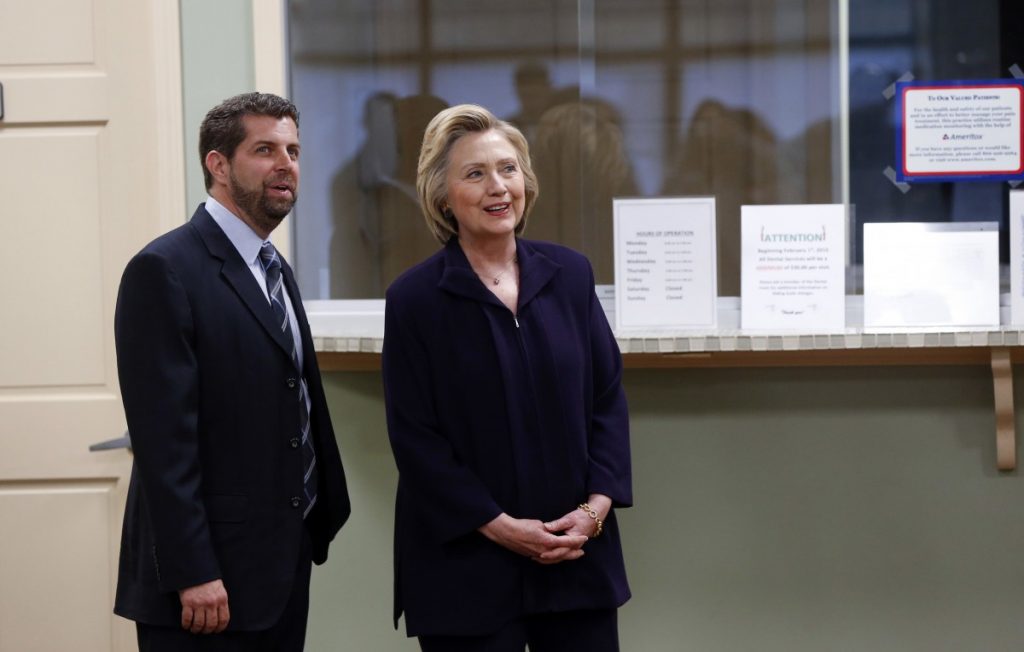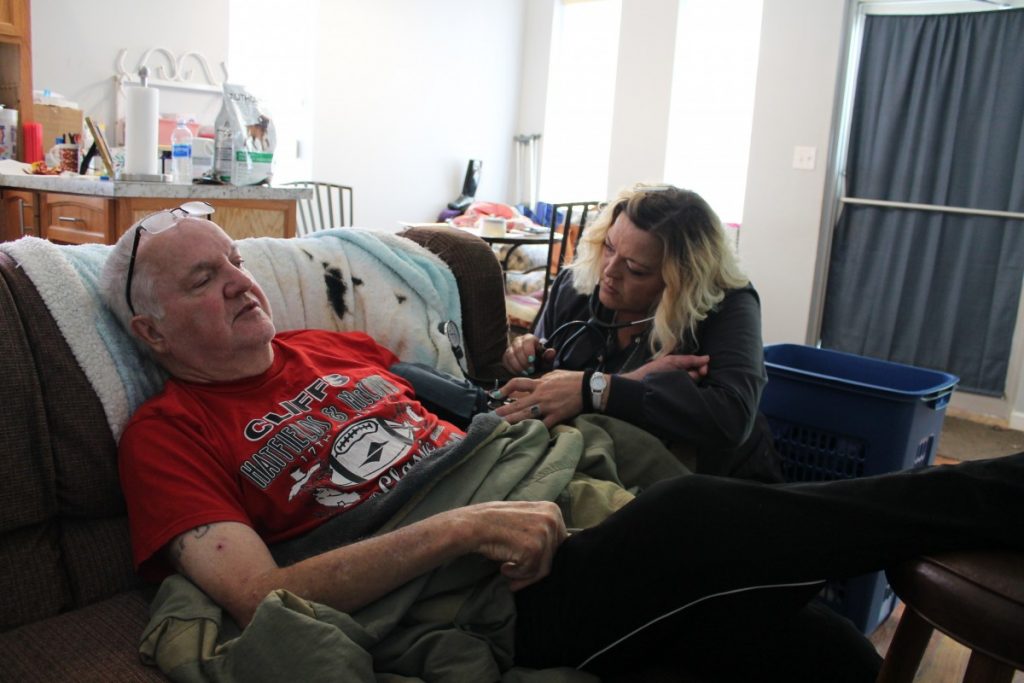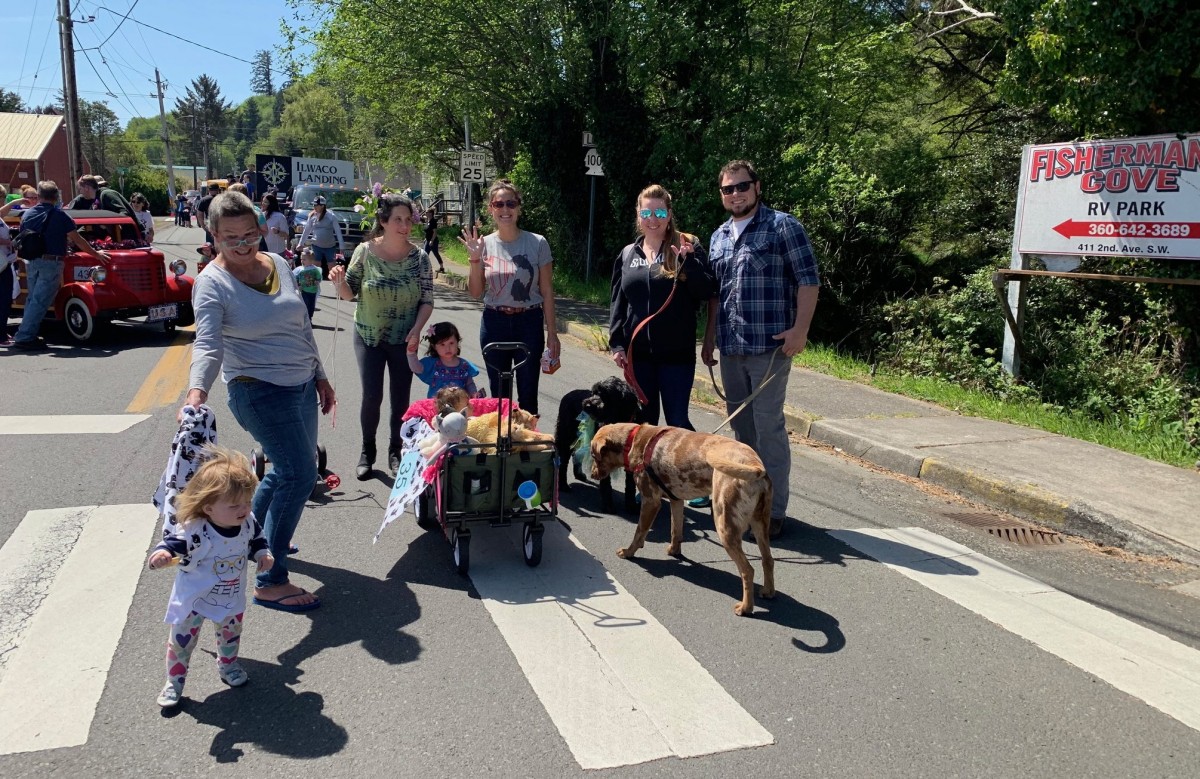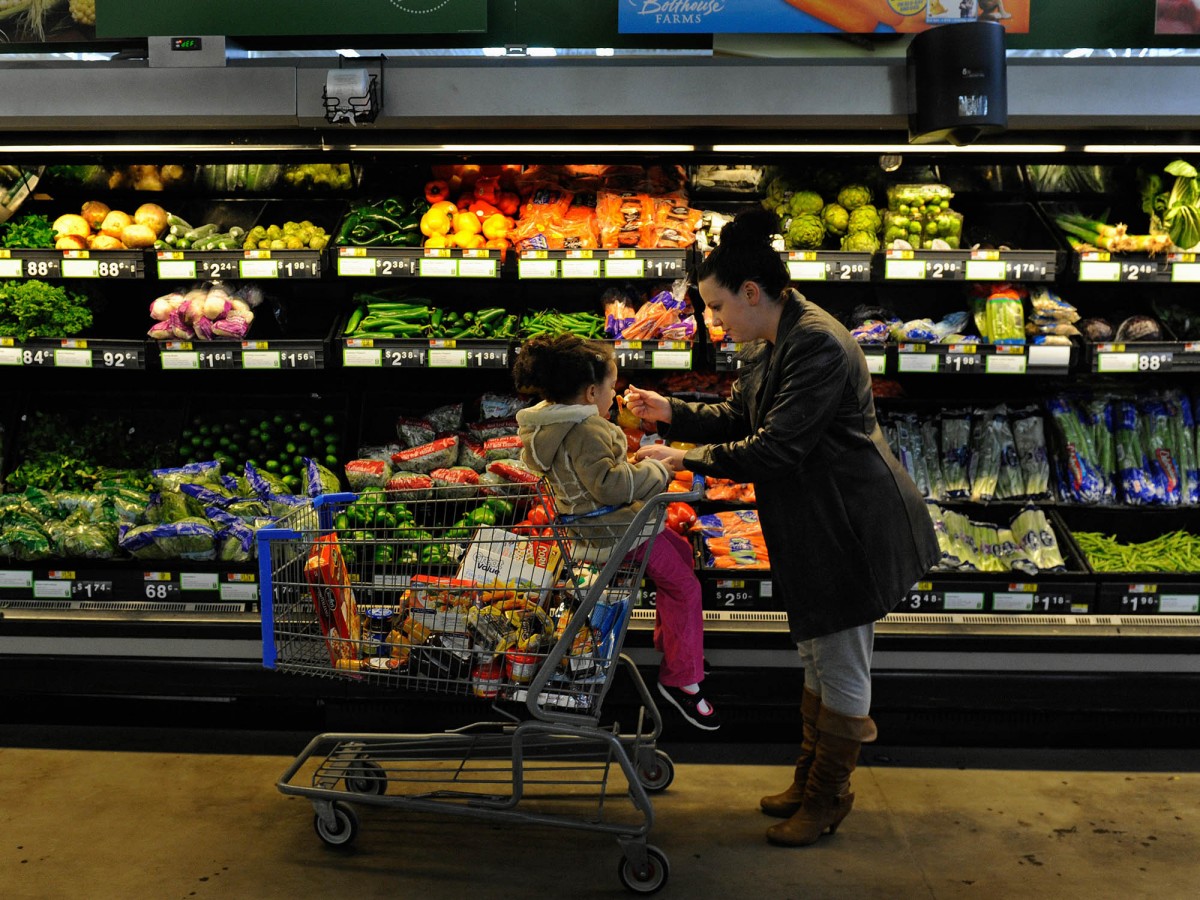Kelly Browning doesn’t wait for Lyle Marcum to come to the door. She knocks and then pushes the glass door open, like she’s been there many times before.
Lyle stays where he is, sitting on a brown love seat, the TV on, and he calls for his dog, Lyla. “Get over here!” She’s running, excited, back and forth, her collar jingling until Kelly finds a leash, connects it to Lyla and slides the rope’s handle over a closet door knob.
“New plan for you,” Kelly laughs. She’s wearing scrubs, but her outfit only describes a portion of the tasks she regularly has to do. As a community health worker for Williamson Health & Wellness Center in Mingo County, West Virginia, Kelly is assigned to 29 of the primary care center’s sickest patients. Most of her patients have more than one chronic disease, or comorbidity, and almost all of them have diabetes.
For two years now, Kelly has been working with Lyle, a former truck driver who hauled coal and mine equipment for most of his life. Since he was diagnosed in 1996, Lyle has spent the better part of two decades with uncontrolled diabetes. For a long time, he didn’t take the drugs doctors prescribed, and he didn’t eat the way they told him to, but he didn’t see any immediate consequences. So he carried on the same way he always had, working until he retired in 2007.
But Lyle’s luck ran out. “Eventually, stuff starts falling apart,” Kelly said. Lyle lost sight in his right eye. He’s now considered legally blind. And he had to have the top quarter of his right foot amputated, losing his toes. But with Kelly’s encouragement and consistent accountability, Lyle’s checking his blood sugar regularly and he’s taking his medications at least most of them.
“They’re death on diabetes,” Lyle said of Kelly and her team. She’s hoping he’s right.
—–
Kelly’s a certified nursing assistant, but if you ask her advisor, Jerome Cline, her most important qualification is that’s she’s called the hills and hollers of Mingo County home her entire life. Kelly has known many of her patients for years. She knows how hard it’s been to find work since the coal industry’s decline in the region, she’s been touched by the opioid epidemic just like too many of her neighbors, and she cares about what happens to her patients.
Diabetes is just one of the many battles her patients face. Type 2 diabetes is considered a public health epidemic throughout the United States, but the disease is especially prevalent throughout lower-income communities in central and southern Appalachia, especially in states like West Virginia, Mississippi and Alabama, which currently lead the nation (1 – 3) in rate of occurrence. One in two West Virginians, for example, have abnormal glucose levels.
The community health worker program, the reason Kelly’s knocking on Lyle’s door every week, is one of the ways that the region is trying to fight back. It’s a new version of a well-known, widely used model that employs community members, without requiring a medical background, to support the health of others. The Department of Family and Community Health at the Joan C. Edwards School of Medicine at Marshall University, located in Huntington, West Virginia, is leading the program’s implementation. The program targets high-risk patients that have diabetes, cardiovascular disease, and/or chronic obstructive pulmonary disease (COPD) in rural areas throughout Appalachia. Rather than relying on regular doctor’s visits to treat diseases like diabetes, which are largely impacted by a patient’s daily decisions, the model moves care upstream into the homes of patients to create opportunities for intervention on a weekly basis.
Community health workers have been working across the world, especially in rural, underserved areas, for decades, said Dr. Richard Crespo, researcher and professor at Marshall’s Department of Family and Community Health. Crespo and his team worked with Duke University to secure grant funding to launch an initial pilot program in 2012 at four health centers, which included Williamson Health & Wellness Center.
The pilot at Williamson focused on 130 high-risk diabetes patients. Within a six-month period, patients reduced their hemoglobin A1C levels by an average of 2.5 percentage points. Rather than using daily glucose readings to track a patient’s sugar management, A1C monitoring offers a much more accurate snapshot by showing average blood sugar level over the previous two to three months.
“If you were a drug company and you dropped hemoglobin A1C by .6 percent, you’d have a multibillion dollar drug,” Dr. Dino Beckett said in a 2018 interview. He’s a physician of osteopathic medicine and the CEO of Williamson Health & Wellness Center.

Due to Williamson’s initial success, Crespo has continued working to secure grant funding through public and private sources to expand the program across the region. The program currently includes 29 community health workers across 13 primary-care centers that are helping to treat 650 high-risk patients living in 27 counties across West Virginia, eastern Kentucky and southeastern Ohio. And based on early results, the majority of patients have been able to make significant improvements to their health.
Crespo’s hopeful this model can offer an alternative, effective path forward for a region that is becoming increasingly sick.
—–
When Craig Robinson started working in Appalachia in the ‘60s and ‘70s to help coal miners with black lung receive medical care, diabetes was around, but it didn’t stand out as a serious public health problem, Robinson said. He’s now the executive director of a primary-care provider in West Virginia.
A lot has changed since then.
Today, more than 30 million Americans, 9.4 percent, have diabetes, according to the American Diabetes Association, with nearly 95 percent experiencing type 2 diabetes, with a disproportionate number living in Appalachia. Diabetes is a slow building disease largely influenced by lifestyle choices over a long period of time — diet, exercise, stress management and so on. Genetic variations also combine with diet and exercise habits to contribute to a person’s overall risk.
If there’s too much glucose in the blood due to a high-glycemic diet — eating large quantities of food with high frequency that cause blood sugar levels to rise like carbohydrates and sugar — the body eventually develops insulin resistance, according to the National Institute of Diabetes and Digestive and Kidney Diseases. And when the body becomes resistant to insulin, it then needs more of it to help glucose enter cells and to keep blood glucose levels down.
“The American diet has become very high in sugar, of course sugary drinks contribute to this,” Robinson said. “We have a very high glycemic diet, which means that our diet tends to make our blood sugar rise and that’s what causes diabetes.”
The Center for Disease Control and Prevention tracks diabetes rates per county throughout the U.S. In 2011, the CDC labeled a 644-county area in the southeast as the “Diabetes Belt.”
To qualify within the belt, counties located in the southeast had to have at least an 11 percent or greater prevalence rate, higher than the national average. Comparing the Diabetes Belt with the map of Appalachia — which spans 420 counties in 13 states from southern New York to northern Mississippi — 232 counties are located within the Diabetes Belt, according to a 2014 report released by the CDC. Every Appalachian county in Mississippi qualified. West Virginia, the only state fully located in Appalachia, had 48 of its 55 counties qualify. It currently leads the nation in rate of occurrence with 15 percent of its population considered diabetic and another 35 percent qualifying as prediabetic.
Residents living in rural, distressed counties throughout Appalachia are 1.4 times more likely to have diabetes than residents of non-Appalachian counties, according to a 2010 report published by the CDC. To identify “distressed” counties, the Appalachian Regional Commission, a partnering federal organization, examines poverty rate, the rate of unemployment and per capita market income over a three-year period of time.
In rural settings, there are many factors that create barriers to healthcare, ranging from geographic isolation, lack of transportation, and decreased health literacy, according to a 2016 report in the West Virginia Medical Journal.
“There’s an association between poor health and low income,” Crespo said. “And for many of the people whose condition is out of control, it’s because of what’s happening in the community.”
—–
When Kelly Browning receives a new patient, before she can start setting health goals, she has to do two things: first, assess her patient’s needs. And second, earn his or her trust.
Cline, the clinical lead for Williamson’s community health worker program, often comes along for the initial home visit. He’s a nurse practitioner and certified diabetes educator, but said there’s no reason to start spouting off how many carbohydrates a diabetic can have with each meal if he enters a patient’s home and sees only a can of stewed tomatoes in the cupboard.
“The thing we have to do when we find it, is address it,” Cline said of food insecurity issues that patients may be experiencing “Because if we don’t address the food shortages, it’s not going to matter.”

In Mingo County, where the coal industry once supported a booming economy, a quarter of residents live in poverty, and the life expectancy rate is one of worst in the nation, according to the Institute for Health Metrics and Evaluation.
Because Kelly is a longtime member of the community, she knows the nearby churches and food pantries to call to get her patients connected to more reliable food sources. She also works with a rural bus service to ensure they have transportation to and from their doctor’s appointments. And because she knows that healthier options are often more expensive, rather than asking patients to overhaul their entire diet, Kelly often works with them on portion control to decrease their carbohydrate and sugar intake.
Across the 13 healthcare providers currently active in the program, community health workers have done everything from helping a patient who was sleeping on the floor obtain a bed to organizing the construction of a wheelchair ramp to help another patient easily enter and leave his home.
“When it comes to somebody’s well being, what is too much?” Kelly said.
To ensure comprehensive care, Kelly and her fellow community health worker, Aletta Hatfield, meet with Cline and the program’s overseeing RN, Melissa Justice, once a week to discuss patient care. It’s one of the aspects that makes this community health worker model unique, Crespo said. By placing community health workers on a care coordination team, they don’t have to be experts in medicine to be able to offer comprehensive care. And even on days that they don’t meet, Kelly can call Cline or Justice to ask small questions she doesn’t know the answer to.
“What the community health worker needs to know in our model,” Crespo said, “is what the patient needs to know. So if a patient needs to know how to do their own glucose monitoring, then the community health worker needs to know that.”
Out of the 650 high-risk patients currently enrolled in a community health worker program throughout central Appalachia, 323 of those patients have diabetes. And so far, Crespo said, 54 percent of diabetic patients have been able to lower their A1C levels by an average of two percentage points, which is very significant in clinical terms.
But it’s going to take more than lowering A1C levels to ensure that this kind of work can continue and grow.
—–
Currently, grant funding is the make or break between having or not having community health workers, Crespo said. Some health centers, after seeing initial results, have made their own investment to expand their number of community health workers beyond their grant’s support.
Since 2017, Crespo and his team at Marshall have led quarterly meetings with insurance providers to share results of the programs. Three payers have signed on with select health centers, including Williamson Health & Wellness Center, to develop a model for payment during a temporary test period.
“All payers will say ‘Yeah, primary prevention saves us money, but what they look at is their bottom line at 5 o’clock. And it’s the [reduction in] ED [emergency department] and hospital visits that bring the cost down,” Crespo said.
The American Diabetes Association released research in 2018 reporting the total cost for treating diagnosed diabetes patients rose from $245 billion in 2012 to $327 billion in 2017.
During Williamson’s pilot program, emergency room visits decreased for diabetes patients by 44 percent and overall hospital stays were reduced by more than 30 percent, according to Crespo. They haven’t averaged, yet, how much money community health workers are already saving payers by reducing hospital visits, but Crespo is hopeful that if these trends continue, and if more payers sign on to the model, community health workers like Kelly Browning won’t ever have to worry about job security.
—–

Shortly after Lyle Marcum became one of Kelly’s patients, he peeled a piece of tape off of the bottom of his left foot. Except it wasn’t tape. It was skin.
For months, Kelly treated the wound. But it kept spreading and growing, until eventually he was forced to have the leg amputated slightly below his left knee. Because her patient load requires her to travel throughout Mingo County, Logan County and even crossing the border into Kentucky, Kelly couldn’t make it to Matewan every day to check on Lyle, who lives alone, during his recovery process.
To help with the days she couldn’t visit, Kelly walked into the Matewan Sheriff’s department to ask that someone check on Lyle regularly. She made friends with a young woman that works at the town’s water department to get her to bring food to him. She had the senior center, just a few hundred yards away from his apartment, provide him meals. She even had her own mother stopping by to bring food and offer company.
“You just become whatever they need from you,” Kelly said. For Lyle, that often looks like gentle and sometimes not so gentle encouragement to keep going.
“Me and him have been in some knock down drag outs,” Kelly said.
“I won’t let him give up.”
This story was co-published with Spotlight for Poverty and Opportunity, a nonprofit, nonpartisan site featuring commentaries and original journalism about poverty and mobility. Follow us on Twitter @povertynews. Read the story on their site here.
Anna Patrick is a journalist based in Thomas, West Virginia. A former reporter for the Charleston Gazette-Mail, her work has appeared in the New York Times and CNN’s Parts Unknown. Raised in Appalachia, her work explores the lives of folks who call these mountains home.



